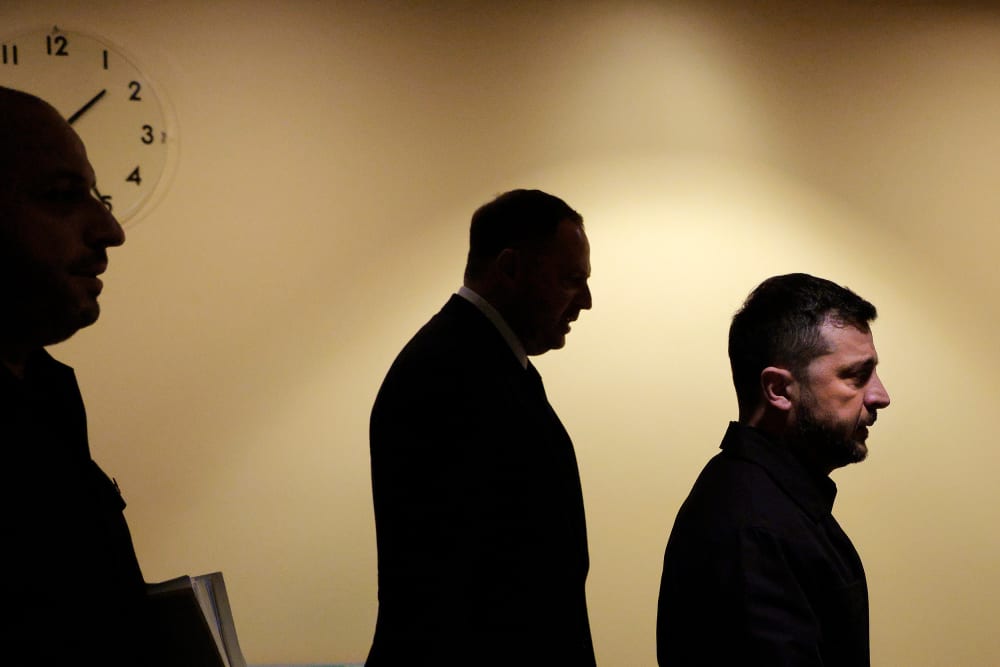It’s unclear if Trump administration officials genuinely think they could get Ukraine and Europe to surrender to the Russia-friendly deal they have proposed to end Vladimir Putin’s war of aggression. But after a year of leaning harder on Ukraine than Russia, it was unlikely the Trump administration would conduct a real pressure campaign against Moscow.
Instead, U.S. and Russian officials worked out a 28-point plan that calls on Ukraine to cede large swaths of territory — including some areas that Russia does not currently occupy — and permanently reduces Ukraine’s military capacity. Putin would merely agree to stop attacking and keep Russian troops out of a small demilitarized zone in areas Ukrainian forces withdraw from. Other rewards for Russian aggression include readmittance to the Group of Eight and an economic deal with the U.S.
With support from Europe, Ukraine will presumably reject at least parts of the proposal as nonstarters.
Ukrainian President Volodymyr Zelenskyy described the proposal as “an extremely difficult choice. Either the loss of dignity” — surrender to Russia — “or the risk of losing a key partner,” the United States. But with support from Europe, Ukraine will presumably reject at least parts of the proposal as nonstarters.
By talking directly to Russia without participation from Ukraine or its European backers, the Trump administration adopted Russia’s distorted frame of statecraft, as if Ukraine’s freedom is America’s to give away.
The proposal includes “security guarantees,” but articulates no specific commitments, only limitations. For example, the deal states “NATO agrees not to station troops in Ukraine,” which means no tripwire guarding against another Russian invasion, reducing the deterrent value. The deal offers no details about an American security guarantee, but says the U.S. “will receive compensation,” treating it more like a protection racket.

Ukrainians know that Russia has broken multiple international deals already — including the 1994 Budapest Memorandum, when Russia agreed to respect Ukraine’s territorial integrity, and the 2014-15 Minsk agreements, which gave Russia some concessions in exchange for promises of peace. They know better than to take Putin at his word, and they’re unlikely to concede land Russia hasn’t been able to take on the battlefield just because Trump asks. Ukraine agreeing to weaken itself would give Russia opportunities to reconsolidate and try for more later – like after Russia’s annexation of Crimea in 2014.
Though Trump officials may threaten to cut off support to Ukraine if Zelenskyy doesn’t accept the proposal by Thanksgiving, Washington’s ability to push Kyiv into a terrible deal is limited. Ukraine benefits from U.S. support but is not entirely dependent on it. American threats to stop intelligence sharing are a progression of Trump administration policy that Ukraine and Europe have already started adjusting to.
Ukraine produces much of its own equipment, in particular small drones, and gets a lot from Europe. Trump and the Republican-controlled Congress already ended U.S. military aid, though Trump did authorize increased arms sales to Europe knowing the weapons were bound for Ukraine. Blocking that could weaken Ukraine but wouldn’t knock it out of the fight, especially not in the short term. And Trump typically likes touting his role in multibillion-dollar contracts for U.S. businesses – not canceling them.
Trump might threaten to leave NATO, trying to frighten European countries into swallowing a bad deal. But the president and his defense secretary already denigrated NATO allies this year, telling them they might be on their own if Russia attacks.
At this point, does anyone really believe that Russian aggression against Estonia, Poland or another Eastern European NATO member would face a strong American response?
NATO is a mutually beneficial alliance, not a U.S. favor to Europe, and NATO’s deterrent power depends on widespread belief that the alliance commitments are credible.











